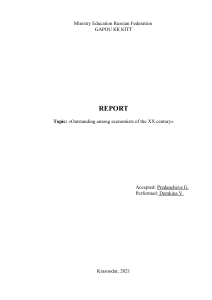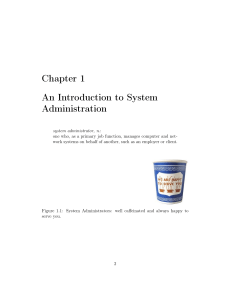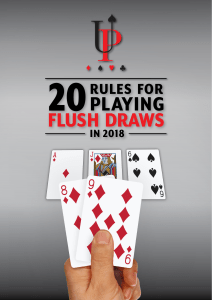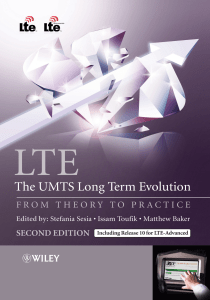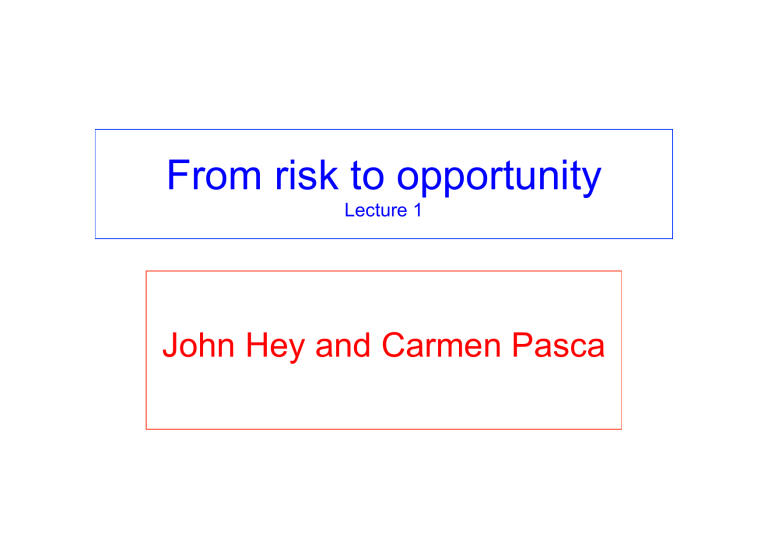
From risk to opportunity Lecture 1 John Hey and Carmen Pasca Welcome • • • • • • • • • • • Welcome... We are Carmen Pasca and John Hey. We will be teaching this course every Friday for 12 weeks. We were given the brief to provide an interdisciplinary course on risk, widely interpreted. It will be interacDve and we look forward to your input... ...though there are lots of you. We have built a website on which you can find material. This is the url: h"p://www-­‐users.york.ac.uk/~jdh1/sciences-­‐po/ We will seek your advice as to when to make material live... ... we believe in incenDves. Comments to Carmen Pasca and/or John Hey are welcome. Lecture 1 IntroducDon: Welcome • We are going to start this course by selling a risky(?) gamble to one of you. • This gamble pays €100 if this fair coin lands Heads (or Tails – the buyer of the gamble chooses). Pays nothing otherwise. This is real money. • First perhaps we should ask you what you understand by the expression “fair coin”? • A physical property of the coin? How tested? • Toss it a large number of Dmes? How many is ‘large’? • The chance/probability of heads/tails is one-­‐half? • Later we show you another way of implemenDng the gamble. Lecture 1 IntroducDon: Rules • We will sell the gamble to one of you with an English aucDon. • Just to make sure that you all understand the aucDon we shall first do a pracDce aucDon. Then we do it for real. • I will count out prices starDng at €1 and increasing in steps of €1 unDl someone buys it (when everyone else has dropped out). • You should put your hand up at any price you would be willing to pay and put it down when the price is too high for you. • The last of you with the hand up will be the buyer and will pay the price at which the penulDmate person put his/her hand down. • The buyer will pay me that money and then he/she will toss the coin, having chosen which side he/she will win €100 with. Lecture 1 IntroducDon: The AucDon 1 2 21 22 41 42 61 62 81 82 3 4 5 23 24 25 43 44 45 63 64 65 83 84 85 6 7 8 9 10 11 12 13 26 27 28 29 30 31 32 33 46 47 48 49 50 51 52 53 66 67 68 69 70 71 72 73 86 87 88 89 90 91 92 93 14 15 16 34 35 36 54 55 56 74 75 76 94 95 96 17 18 19 20 37 38 39 40 57 58 59 60 77 78 79 80 97 98 99 100 These prices are in EUROS. I will show prices in sequence from 0 to 100 until there is only one person with his or her hand up. That person will be the buyer, will pay me the price at which the penultimate person dropped out; and will then toss the coin – being paid €100 or €0 depending upon how the coin lands. First we do a practice… …then the real thing. Note in the real thing it is real money. (For the future note where YOU drop out.) Lecture 1 IntroducDon: Playing it out • OK – we have a winner of the aucDon… • …paying a price of €? • What side do you want to win on? • OK – toss the coin... Lecture 1 IntroducDon: What do we infer? • • • • What do we conclude? First ask: what is the Expected Value of the gamble? What does this mean? If you dropped out at a price before this you are risk-­‐ averse. • If you dropped out at this price you are risk-­‐neutral. • If you dropped out at a price aeer this you are risk-­‐ loving. Or mad? • We note that risk-­‐aftudes vary across people. Lecture 1 IntroducDon: Risk and ambiguity • • • • • • Suppose instead of the coin we used this Bingo Blower. In this there are 5 blue balls, 3 yellow and 2 pink. The buyer chooses either blue or yellow and pink. What is the chance/probability of winning/losing? Or what if we used this Bingo Blower? This is what is called by economists a situaDon of ambiguity – the probabiliDes exist but they are not known. • At what price would you drop out of this aucDon? • Is this price the same price at which you dropped out of the aucDon with the fair coin? Lecture 1 IntroducDon: Overview of lecture • What we are going to do today. • Give a general introducDon to what we might mean by risk. • Provide a general discussion of how people should/ might/do react to whatever it is we mean by risk. • Discuss whether the ‘authoriDes’ should intervene in some way in situaDons of risk. • Give a general overview of the course. • Conclude with another ‘bet’. Lecture 1 IntroducDon: what is Risk? • Rather trivially, risk is the absence of certainty about what will happen. • Different disciplines have different ways of characterising ‘risk’. • Economists like to simplify things – into • Risk – where there are known probabiliDes (whatever they are) of the various possibiliDes (subjecDve or objecDve); • Ambiguity – where the possibiliDes can be listed but probabiliDes can not be anached to them. • Economists do not like situaDons where the possibiliDes are themselves unknown, but other disciplines are less shy. Lecture 1 IntroducDon: How should/do people react? • Many disciplines have theories about how people should/do behave under situaDons of risk. • Economists like to start with axioms, and if people agree with these axioms, then they should behave in accordance with the implied preference funcDonal – for example, Expected UDlity theory. • Are certain axioms/theories more raDonal? (Are risk-­‐lovers mad?) • Other disciplines (parDcularly psychology and sociology) are more behavioural and try to describe how people do behave. Lecture 1 IntroducDon: RegulaDon • Is there a need for government intervenDon/ regulaDon? • If people have been ‘sold’ bad informaDon? • If people do not know the ‘correct’ probabiliDes? • If people have the ‘wrong’ aftude to risk? • If people have a ‘wrong’ preference funcDonal? • Do people need to be protected from themselves? • How can allegedly true probabiliDes be verified ex post? Lecture 1 IntroducDon: Overview of lectures 2. 3. 4. 5. 6. 7. 8. 9. 10. 11. 12. An historical perspective Different approaches to risk Philosophical approaches to risk Epistemological approaches to risk Political approaches to risk Sociological approaches to risk Psychological approaches to risk Economic approaches to risk Expected Utility theory Implications of Expected Utility Market Implications and Overview Looking forward to Lecture 2: Historical approaches • In this lecture we will discusses the historical evoluDon of the risk concept: from ancient civilizaDons, passing to the Middle-­‐Age and Modern period and then to the contemporary period. • For the 20th century, first we expose the most famous definiDons of risk and uncertainty, those elaborated by Knight and Keynes. • Second, we focus on the relaDonship between risk and globalisaDon, risk and science, risk and technologies, and innovaDons. Looking forward to Lecture 3: Different approaches to risk • This lecture sets the scene for subsequent lectures by discussing the various different approaches to risk in the social and human sciences: philosophical, epistemological, poliDcal, sociological, ethical, psychological and economic; it also explores the relaDonships and connecDons between these different approaches. • In parDcular, this lecture focuses on how the issue of risk gave rise to important new problems for several disciplines. Looking forward to Lecture 4: Philosophical approaches to risk • This lecture examines the work of the key philosophers during the modern and contemporary periods who wrote about risk: Pascal, Descartes, Rousseau, Rawls, Karl Popper and Richard Rorty. • Philosophical ideas include dealing with: cause and effect; uncertain knowledge; defining human values; measuring values; experts; the role of science in society; the role of judgment in human affairs. Looking forward to Lecture 5: Epistemological approaches to risk • This lecture examines the transformaDon of risk into an abstract concept; this started in the eighteenth century, at the iniDaDve of Buffon, Laplace and Condorcet; and conDnued into the twenDeth century with Keynes, Savage and Allais. • The use of this term is based on a subtle combinaDon of knowledge and uncertainty. • The epistemological understanding and definiDon of risk will be invesDgated from a mulDdisciplinary approach. Looking forward to Lecture 6: PoliDcal approaches to risk • This lecture looks at the way poliDcal analysts portray risk as having a fundamental role in contemporary poliDcal society. • When viewing the policy and poliDcal process in poliDcal risk terms, we discover that there is a need to explore the various nuances and observaDons made about risk more generally. • The poliDcal concept of risk is related to the approach for understanding and appreciaDng poliDcs and public policy making: risk and regulaDve poliDcs. Looking forward to Lecture 7: Sociological approaches to risk • This lecture covers the work of sociologists in the field of risk going from Max Weber’s Theory of RaDonality to the Risk Society of Ulrich Beck, and explores the relaDonship between concepts of raDonality used by sociologists and those used by economists. • The idea of “reflexive modernizaDon,” on the other hand, is not just central to Beck’s theory of Risk Society, but is also a keystone to the thinking of a number of other European thinkers—Anthony Giddens, Scon Lash, M.Douglas, Niklas Luhmann. Looking forward to Lecture 8: Psychological approaches to risk • Some of the psychological theories of decision under risk appear to have been introduced as a consequence of empirical dissaDsfacDon with Expected UDlity theory (which we start by discussing briefly and then give more detail in Lecture 9). • Coombs developed an alternaDve he called porFolio theory (a terminological choice confusing to economists). • Kahneman and Tversky developed a criDque of expected uDlity theory as a descripDve model of decision making under risk, and produced their own, which they call prospect theory. • This has since undergone several revisions. • We note that these psychological approaches are usually based on the process through which people take decisions. Looking forward to Lecture 9: Economic approaches to risk • Economists, perhaps starDng with von Morgenstern and Morgenstern and their followers, like to impose concepts of raDonality on the analysis of behaviour under risk; and hence start with axioms of raDonal behaviour. • We note that this approach differs from psychological approaches – which are more concerned with the processes by which people take decisions. • The most famous economic theory is Expected UDlity Theory. • [We examine experimental evidence casDng doubt on Expected UDlity theory. • We then go on to discuss new economic theories (based on less restricDve axioms) that have been proposed in the light of the experimental evidence – most notably Prospect Theory or Rank Dependent Expected UDlity theory.] • We then show how Expected UDlity theory can also cover situaDons of ambiguity – where probabiliDes are not known. • And in so doing, we show that if economic agents follow the reasonable axioms of SEUT, they act as if they anach probabiliDes to uncertain events. Looking forward to Lecture 10: Expected UDlity Theory • • • • • • • • • This is the most popular theory used in economics, though it does have its criDcs. It says that individuals choose between risky gambles on the basis of the uDlity expected from them. We state the underlying axioms of the theory. Most crucial is Independence: if an individual prefers a to b then that individual prefers [gefng a with probability p and some c with probability 1-­‐p] to [gefng b with probability p and the same c with probability 1-­‐p]. Then we look at the implicaDons in staDc problems under risk. We generalise briefly to dynamic problems and then to those under ambiguity (where probabiliDes do not exist). We discuss the axioms underlying (S)EUT. We discuss the implicaDons. We briefly menDon the circumstances under which (S)EUT reduces to Mean/ Variance theory (much used in Finance). Looking forward to Lecture 11: ImplicaDons and ApplicaDons of EU • This lecture examines the way that EU has and can be used. • We show you how you can find your own (EU) uDlity funcDon and hence understand how risk-­‐averse you are. • We will look at two measures of risk aversion and loving: absolute and relaDve. • We look at two parDcular popular uDlity funcDons (CARA and CRRA) • Examples of the use of Expected UDlity theory in economics: 1. The theory of the compeDDve firm facing price uncertainty. 2. The life-­‐cycle savings problem under income risk. Looking forward to Lecture 12: Market ImplicaDons and Overview • The first part of this lecture looks at implicaDons of EU in a market context. • We discuss how insurance works. • We note that if people are insured then the probabiliDes of the risks may change (moral hazard). • We discuss the problems when the insurer is not sure about the probabiliDes (adverse selecDon). RegulaDon? • We also show how the exchange of risks is mutually beneficial even if everyone is risk-­‐averse – exchange is an opportunity. • The final part of this lecture briefly summarises From Risk to Opportunity as a whole. Lecture 1: A concluding bet • Let us conclude with a simple bet on the French stock index – CAC40. • You can either bet on it going up by 14.55 on Friday the 14th of September relaDve to its level at this moment, or it going down. • Write your name and your bet (Up or Down) on a bit of paper and give the bit of paper and €1 to us. • If n students bet, we will next week divide the €n we have collected collecDvely to the set of m students who bet on the right event (so each gets €n/m). • In the unlikely event that the index does not change, we shall refund all bets. Lecture 1 • Goodbye!
![[slivysklad.com] IRREGULAR VERBS](http://s1.studylib.ru/store/data/006351451_1-39767cc2343f3f3dcd5f7d6a4fe9b5b1-300x300.png)

